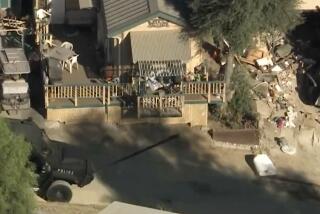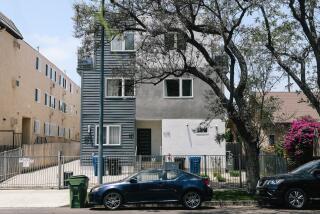Police ‘Battering Ram’ Used in New Dope Raid
- Share via
Los Angeles police used their controversial new “motorized battering ram” to enter another suspected cocaine “rock house” Wednesday night--but with better results than on its first outing.
This time, they said, they found several grams of rock cocaine and they recovered some marked money with which they had made an undercover buy earlier in the day.
Members of the Special Weapons and Tactics team surrounded the stucco house at on West 111th Street in South Los Angeles at about 6:30 p.m., used a bullhorn to demand entry--and the ram smashed through a wall at the rear of the building a few minutes later.
SWAT officers, who poured into the building in the wake of the ram, arrested a 16-year-old girl, a 14-year-old boy and a 17-year-old boy. They were booked as juveniles, but police said the elder boy was also wanted on a previous warrant charging felony cocaine sales.
No weapons were found on the premises, and no one was injured in the raid.
Lt. Dick Koskelin, who heads the field enforcement unit of South Bureau Narcotics, called the building “a typical rock house--as you can see, it’s devoid of anybody living here. There are no utilities turned on, including water. The last time anyone lived here legally was in December.”
The building was heavily fortified, with steel front and back doors, steel mesh-covered windows and steel bars also protecting inside doorways.
Police Chief Daryl F. Gates was on the scene, but did not ride in the passenger seat of the armored car as he did the first time the weapon was used.
Neighbors who gathered outside the house, drawn to the scene by the noise and confusion, were mixed in their reactions to the police operation.
“I love it,” said Yvonne Walker, 31, who lives next door to the suspect house. “I don’t want (dope) in my community, and no other community. . . .”
Ernie Thomas, 21, who lives across the street, was equally enthusiastic.
“I think it’s great. I been living here 15 years and we’ve never had no problems before. I want this (cocaine dealing) to stop,” he said.
But Gene Amos, 39, who lives a few houses away in the same block, wasn’t so sure.
“Who pays for it?” he demanded. “What’s going to happen if they hit a gas line? I don’t go along with these rock houses--but there’s got to be a safer method of getting inside them.”
Police used their new quick-entry device--which is an armored personnel carrier equipped with a 14-foot metal battering ram--for the first time last Wednesday, when they smashed a hole in the wall of another suspected rock house at 13037 Louvre Street, Pacoima.
Occupants at that house were two women and three children. The husband of one of the women was subsequently arrested on suspicion of possessing cocaine for sale.
Sheriff’s narcotics officers later disclosed that the house raided last Wednesday is owned by Jeffrey A. Bryant, 33, who had been arrested June 27, 1984 in connection with alleged cocaine operations in another house he owns--next door, at 13031 Louvre Street.
Only a small amount of cocaine was found in the raid last week, and a small quantity of marijuana was confiscated. Use of the battering ram raised a storm of protest.
Nearly 100 representatives of Pacoima religious, civil rights and community groups came to the Police Commission meeting Monday to demand restrictions on use of the wall-smashing armored car.
Jose De Sosa, president of the San Fernando Valley chapter of the NAACP asked the commission to reprimand Gates for his “reckless and unreasonable decision” to use the device.
“The entire community is much disturbed,” said the Rev. T. G. Pledger, vice president of the Pacoima Ministers Assn. “This is a total disgrace to the human race.
Police Commission President Stephen D. Yslas said the commission would look into the matter and “undertake to develop an appropriate criteria for this tank.”
But he stopped short of promising that the ram would not be used while the criteria were being developed.
More to Read
Sign up for Essential California
The most important California stories and recommendations in your inbox every morning.
You may occasionally receive promotional content from the Los Angeles Times.









